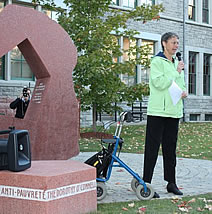Act Now

Empower U: Learn to Access Your Disability Rights Training on Canadian Human Rights, the Convention on the Rights of Persons with Disabilities (CRPD) and its Optional Protocol (OP) training aims to increase awareness of how to address discrimination using more familiar Canadian human rights laws such as Human Rights Codes and the newer international Convention on the Rights of Persons with Disabilities (CRPD). This is training for persons with disabilities by persons with disabilities. The training is part of a project funded by Employment and Social Development Canada and implemented by the Council of Canadians with Disabilities (CCD) in collaboration with Canadian Multicultural Disability Centre Inc. (CMDCI), Citizens With Disabilities – Ontario (CWDO), Manitoba League of Persons with Disabilities (MLPD) and National Educational Association of Disabled Students (NEADS). Read more.
Sign Up for our monthly digest
A monthly newsletter from CCD about what is happening in the community
What To Ask Federal Election Candidates about Employment
Related Documents
April 27, 2011
We Are Electors. We Are Women with Disabilities.
April 26, 2011
What to Ask Federal Election Candidates about Women with Disability?
April 14, 2011
Conservative Government Has Future-oriented Approach to Disability Issues
Short Term
Will Your Party:
- Set participation goals for Canadians with disabilities in labour market agreements with provinces and territories? (Federal funds should not be transferred unless these goals are met.)
- Expand the contribution to the Multilateral Framework Agreement on Labour Force Participation of People with Disabilities and the Opportunities Fund to create more employment opportunities for Canadians with disabilities.
Long Term
Will your Party commit to:
- Making the Government of Canada a model employer, both in its hiring and disability accommodation practices?
- Achieving the goal of equitable representation of people with disabilities at all levels of the federal public service?
Inform candidates about unemployment and people with disabilities
- The working-age population includes 2.4 million Canadians with disabilities and 18.7 million without disabilities.
- Women are slightly more likely than men to report disability (53.2% vs. 46.8%) and are generally less likely to be employed than men, which is in part due to childrearing and elder care responsibilities which fall disproportionately to women.
- Working age Canadians with severe/very severe disabilities have a weak relationship to the labour force, with an employment rate of 36.7 percent, an unemployment rate of 12.3 percent, a participation rate of 41.9 percent, and 68.9 percent work for small employers and do not belong to a union
- The Organization for Economic Co-operation and Development reports that, "Overall spending on active labour market programs (ALMP) for persons with disabilities is less than 0.1% of GDP: 0.06% of GDP for federal programs plus another 0.01-0.03% of (provincial) GDP, depending on the province, for additional provincial programs. While this is more than what is being spent in other English-speaking countries, it is much less than the 0.5% (or more) of GDP spent in countries that are making an impact, such as Denmark, and half of the ALMP spending level in Switzerland – two countries in which the employment rate of persons with disabilities is almost 10 percentage points higher than in Canada. There is considerable room for reorienting Canadian investment towards a more active disability policy to make the expenditure yield better results (OECD, Sickness , Disability and Work: Breaking the Barriers, 44-45).”
Election 2011 Fact Sheet 2

Marie White, a former Chairperson of CCD, addresses anti-poverty rally.
